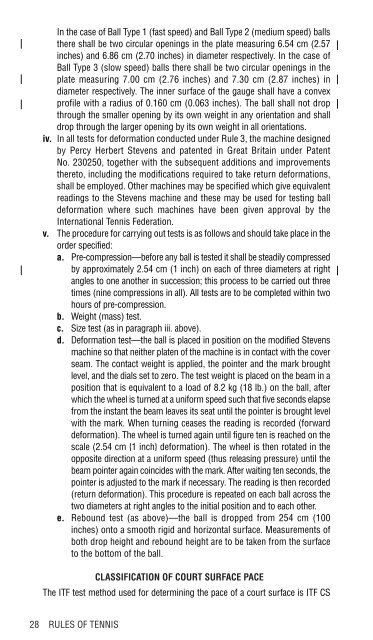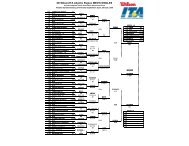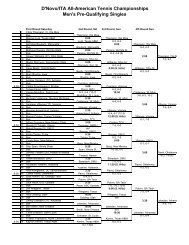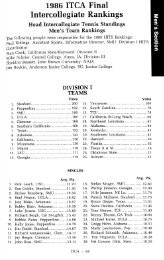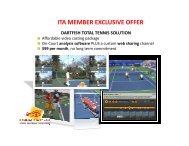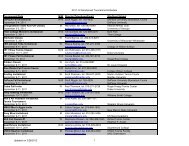Friend at Court - Intercollegiate Tennis Association
Friend at Court - Intercollegiate Tennis Association
Friend at Court - Intercollegiate Tennis Association
You also want an ePaper? Increase the reach of your titles
YUMPU automatically turns print PDFs into web optimized ePapers that Google loves.
In the case of Ball Type 1 (fast speed) and Ball Type 2 (medium speed) balls<br />
there shall be two circular openings in the pl<strong>at</strong>e measuring 6.54 cm (2.57<br />
inches) and 6.86 cm (2.70 inches) in diameter respectively. In the case of<br />
Ball Type 3 (slow speed) balls there shall be two circular openings in the<br />
pl<strong>at</strong>e measuring 7.00 cm (2.76 inches) and 7.30 cm (2.87 inches) in<br />
diameter respectively. The inner surface of the gauge shall have a convex<br />
profile with a radius of 0.160 cm (0.063 inches). The ball shall not drop<br />
through the smaller opening by its own weight in any orient<strong>at</strong>ion and shall<br />
drop through the larger opening by its own weight in all orient<strong>at</strong>ions.<br />
iv. In all tests for deform<strong>at</strong>ion conducted under Rule 3, the machine designed<br />
by Percy Herbert Stevens and p<strong>at</strong>ented in Gre<strong>at</strong> Britain under P<strong>at</strong>ent<br />
No. 230250, together with the subsequent additions and improvements<br />
thereto, including the modific<strong>at</strong>ions required to take return deform<strong>at</strong>ions,<br />
shall be employed. Other machines may be specified which give equivalent<br />
readings to the Stevens machine and these may be used for testing ball<br />
deform<strong>at</strong>ion where such machines have been given approval by the<br />
Intern<strong>at</strong>ional <strong>Tennis</strong> Feder<strong>at</strong>ion.<br />
v. The procedure for carrying out tests is as follows and should take place in the<br />
order specified:<br />
a. Pre-compression—before any ball is tested it shall be steadily compressed<br />
by approxim<strong>at</strong>ely 2.54 cm (1 inch) on each of three diameters <strong>at</strong> right<br />
angles to one another in succession; this process to be carried out three<br />
times (nine compressions in all). All tests are to be completed within two<br />
hours of pre-compression.<br />
b. Weight (mass) test.<br />
c. Size test (as in paragraph iii. above).<br />
d. Deform<strong>at</strong>ion test—the ball is placed in position on the modified Stevens<br />
machine so th<strong>at</strong> neither pl<strong>at</strong>en of the machine is in contact with the cover<br />
seam. The contact weight is applied, the pointer and the mark brought<br />
level, and the dials set to zero. The test weight is placed on the beam in a<br />
position th<strong>at</strong> is equivalent to a load of 8.2 kg (18 lb.) on the ball, after<br />
which the wheel is turned <strong>at</strong> a uniform speed such th<strong>at</strong> five seconds elapse<br />
from the instant the beam leaves its se<strong>at</strong> until the pointer is brought level<br />
with the mark. When turning ceases the reading is recorded (forward<br />
deform<strong>at</strong>ion). The wheel is turned again until figure ten is reached on the<br />
scale (2.54 cm {1 inch} deform<strong>at</strong>ion). The wheel is then rot<strong>at</strong>ed in the<br />
opposite direction <strong>at</strong> a uniform speed (thus releasing pressure) until the<br />
beam pointer again coincides with the mark. After waiting ten seconds, the<br />
pointer is adjusted to the mark if necessary. The reading is then recorded<br />
(return deform<strong>at</strong>ion). This procedure is repe<strong>at</strong>ed on each ball across the<br />
two diameters <strong>at</strong> right angles to the initial position and to each other.<br />
e. Rebound test (as above)—the ball is dropped from 254 cm (100<br />
inches) onto a smooth rigid and horizontal surface. Measurements of<br />
both drop height and rebound height are to be taken from the surface<br />
to the bottom of the ball.<br />
CLASSIFICATION OF COURT SURFACE PACE<br />
The ITF test method used for determining the pace of a court surface is ITF CS<br />
28 RULES OF TENNIS


